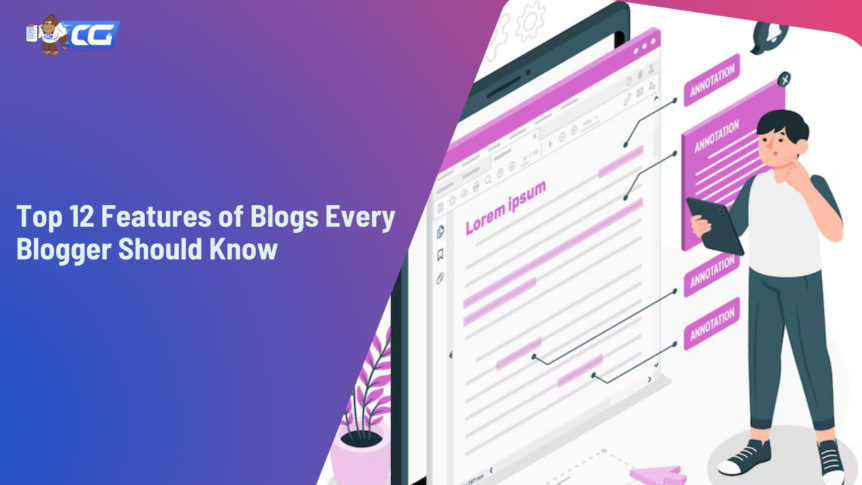Blogging is an art, much like the performances on America’s Got Talent. Some contestants in this show do really well and receive enthusiastic applause from the judges. Do you want your blog to receive the same applause and appreciation from your audience? To make this happen, you need to make your blog truly exceptional! This means crafting content that resonates, engages, and stands out. But do you only require well-crafted content to take your blog up a notch? What features of blogs make them stand out?
Source: Giphy
In today’s world of modern blogs, specific features of a blog are as important as the content itself – design, user experience, and SEO, to name a few. These factors can make or break your blog. In this post, we’ll break down the essential features of blogs to elevate them beyond just great content.
What Blogs Are and Why They Matter
Source: Freepik
Blogs are regularly updated websites where people share their thoughts, opinions, and experiences with others on different topics. The main purpose of a blog is to provide information, share ideas, and engage with an audience. By consistently creating and sharing valuable content, bloggers can:
- Attract and retain a loyal audience.
- Drive website traffic.
- Generate qualified leads.
- Grow their online presence.
- Establish themselves as industry experts.
- Monetize their content effectively.
12 Essential Features of a Blog
Whether you’re running a personal blog or a top business blog, you want to create an experience that resonates with your audience and drives real results. If that’s so, you need to nail the essentials! Get ready, we’re about to dive into the top 12 features of blogs to make your blog content shine and attract the attention it deserves.
User-Friendly Interface
A user-friendly interface is your blog’s first impression. Easy navigation and thoughtful layout choices make the blog a pleasure to explore. Overall, it keeps readers engaged seamlessly and encourages them to explore even more content.
Let’s face it, no one wants to spend ten minutes hunting for your latest post(s). Remember, if users struggle to find what they need, they’ll bounce faster than you can say ‘blog’. So, keep it easy, keep it engaging.
Responsive Design
According to Josh Wilson, an experienced graphic designer: “Responsive Web Design always plays an important role whenever going to promote your website”. Replace the term ‘website’ here with ‘blog’ to understand this quote better in context. In today’s mobile-driven world, a responsive layout is a must-have for your blog.
It ensures your blog looks sharp and functions flawlessly on any screen, be it a smartphone, tablet, or desktop. It not only enhances user experience but also boosts SEO. Google loves mobile-friendly sites, and so do your readers!
Categories and Tags
Think of categories and tags as your blog’s filing system. They help organize your content, making it easier for readers to find related posts. Simply put, categories group similar posts together, while tags offer more specific labeling for each blog post.
Interestingly, categorizing similar posts together means you’re internally linking them. This not only enhances the user experience on your blog but also improves its SEO. It’s an integral element to include in your blog.
Search Functionality
Imagine a reader visits your blog and there’s no search bar. Frustrated, they scroll for ages but find nothing relevant. Expectedly, they leave, saying ‘Ugh’. If you don’t want this to happen to you, be sure to add a search bar to your blog.
Upon exploring the Content Gorilla Blog, you’ll find a search button in the menu bar. Type in your query and you’ll get numerous related blog posts. A built-in search bar lets readers find exactly what they’re after, whether it’s a yummy donut🍩 recipe or a quick makeup💄 tutorial.
Post Archive Section
Do you want readers to effortlessly browse through your archives to discover older posts or catch up on missed articles? If so, consider including a post archive section in your blog as a must.
The main purpose of a post archive section is to keep all your older posts easily accessible for the readers. It’s like a library where all your blog posts are organized by date, so anyone can explore any article from and at any time. It’s that simple!
High-Quality Content
What makes a blog successful? At the heart of any successful blog lies consistently exceptional content. It’s what keeps readers coming back for more. So, publish well-researched, engaging, and high-quality content that addresses your audience’s needs and interests.
High-quality content builds authority, drives traffic, and encourages social sharing. Now, what are two key elements that form the foundation of a well-written blog? First, craft engaging and interesting titles to draw readers in. Second, cut the fluff and keep it concise for easy readability.
Appropriate Post Structure
Building on high-quality content, blog post structure is another crucial blog feature. A well-structured and logically organized blog post helps readers and scanners find what they’re looking for quickly. Use headings, subheadings, and bullet points to break up text.
This not only makes your posts easier to read and digest but also keeps visitors engaged longer. On top of that, it helps search engines better understand your content. It then leads to improved rankings and faster site indexing.
Multimedia Integration
Multimedia breaks up the monotony of plain text. It keeps readers engaged, and can explain complex concepts in a flash. So, don’t forget to spice up your written content with captivating visuals.
Add images, infographics, memes, videos, or charts that make your blog more visually appealing. Did you know blog posts with images receive 94% more traffic than those without.
SEO Focus
Once you finish writing a blog post, optimize it for search engines to attract organic traffic (audience). Effective on-page SEO, including keyword-rich titles, descriptions, meta tags, and alt text, helps your blog rank higher in search results.
Here’s a crucial tip we often test successfully on our blogs. Keep your blog post’s content and structure easy to follow. Remember, the goal is to be found, so make it easy for search engines. This increases the chances of your blog post showing up in search results and ranking higher.
Comments Section
A comments section is a space for readers to share their thoughts about your content and ask questions. It fosters a sense of community and keeps people coming back for more. Your role here is crucially important.
Encourage discussion by responding to your readers’ comments. This interaction can lead to loyal followers of and valuable feedback on your content. It lets you know what your readers like and dislike, allowing you to tailor your content accordingly.
Social Media Integration
Making your content easy to follow not only helps you rank higher on Google but also makes it easier for readers to share it on social media platforms. Trust us when we say it’s a free + super-effective marketing strategy.
This digital cross-pollination drives more traffic to your blog site which helps you build an audience beyond your blog. So, make sure to include social sharing buttons and encourage your readers to like, share, and pin your posts.
Blog Footer
A blog footer is the last section at the bottom of your blog site. It typically includes essential web page links, copyright information, social media icons, a newsletter signup, and contact information.
This section promotes navigation, provides important information, and encourages reader engagement. Its main focus is to offer a seamless way for readers to explore the blog further and stay connected.
In essence, these are the characteristics of good blogs. Whether you’re starting a personal blog or upgrading your existing one, these are the key features of blogs to focus on.
[Bonus] Tips to Take Your Blog To The Next Level
Lastly, we’ll share 5 valuable tips as the blog post best practices to take your blog to the next level.
- Style content for scanners (not only readers). That’s because the average person spends just under 40 seconds reading a blog post.
- Update content regularly to keep readers engaged and improve SEO rankings.
- Repurpose old posts to maximize their life span and impact.
- Encourage subscriptions to nurture relationships and drive traffic with targeted email campaigns.
- Develop in-depth, authoritative (pillar) articles. They help you position your blog as a go-to resource.
Conclusion
Today, we covered 12 essential features of blogs and key tips to elevate your blog. And if content is king, then titles are the crown. Want to craft catchy titles? Try our Free Blog Post Idea Generator. It helps you create unlimited, customizable blog titles for your posts, in seconds!

I am a full-time online marketer, for over a decade now. Helped over 100,000+ people & generated well over $12M in online sales.

